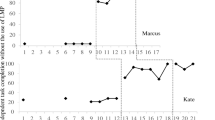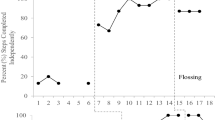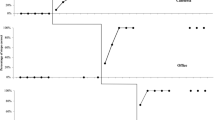Abstract
Students with autism spectrum disorder (ASD) and intellectual disability (ID) may experience challenges when learning tasks that are complex and require numerous steps. This difficulty can lead to employment issues for this population of learners. Therefore, researchers have explored methods to teach employment-related tasks to students with ASD and ID. Two such procedures are video prompting (VP) and least-to-most prompting. These procedures are frequently combined as an intervention package to boost student responding. The purpose of this study was to explore which of these interventions was more effective and efficient when used to teach office tasks to individuals with ASD and ID. Three adolescent students participated in this study. Using the adapted alternating treatments design, we found that VP was more effective and efficient for two participants, whereas least-to-most prompting was more effective but less efficient for the remaining participant. Implications for research and practice are discussed.

Similar content being viewed by others
References
Alexander, J. L., Smith, K. A., Mataras, T., Shelpey, S. B., & Ayres, K. M. (2015). A meta-analysis and systematic review of the literature to evaluate potential threats to internal validity in probe procedures for chained tasks. Journal of Special Education, 49, 135–145. https://doi.org/10.1177/0022466914550096.
Ayres, K. M., & Ledford, J. R. (2014). Dependent measures and measurement systems. In D. L. Gast & J. R. Ledford (Eds.), Single case research methodology: Applications in special education and behavioral sciences (2nd edn., pp. 124–153). New York: Routledge.
Banda, D. R., Dogoe, M. S., & Matuszny, R. (2011). Review of video prompting studies with persons with developmental disabilities. Education and Training in Autism and Developmental Disabilities, 46, 514–527.
Bellini, S., & Akullian, J. (2007). A meta-analysis of video modeling and video self-modeling interventions for children and adolescents with autism spectrum disorders. Exceptional Children, 73, 264–287. https://doi.org/10.1177/001440290707300301.
Bennett, K. D., Aljehany, M. S., & Altaf, E. M. (2017). Systematic review of video-based instruction component and parametric analyses. Journal of Special Education Technology, 32, 80–90. https://doi.org/10.1177/0162643417690255.
Bennett, K. D., Gutierrez, A., & Honsberger, T. (2013). A comparison of video prompting with and without voice-over narration on the clerical skills of adolescents with autism. Research in Autism Spectrum Disorders, 7, 1273–1281. https://doi.org/10.1016/j.rasd.2013.07.013.
Cannella-Malone, H., Miller, O., Schaefer, J. M., Jimenez, E. D., Page, E. J., & Sabielny, L. M. (2016). Using video prompting to teach leisure skills to students with significant disabilities. Exceptional Children, 82, 463–478. https://doi.org/10.1177/0014402915598778.
Cannella-Malone, H. I., Chan, J. M., & Jimenez, E. D. (2017). Comparing self-directed video prompting to least-to-most prompting in post-secondary students with moderate intellectual disabilities. International Journal of Developmental Disabilities, 63, 211–220. https://doi.org/10.1080/20473869.2017.1301695.
Cannella-Malone, H. I., Sabielny, L. M., Jimenez, E. D., & Miller, M. M. (2013). Pick one! Conducting preference assessments with students with significant disabilities. Teaching Exceptional Children, 45(6), 16–23. https://doi.org/10.1177/004005991304500602.
Cooper, J. O., Heron, T. E., & Heward, W. L. (2007). Applied behavior analysis (2nd edn.). Upper Saddle River: Pearson.
DeLeon, I. G., & Iwata, B. A. (1996). Evaluation of a multiple-stimulus presentation format for assessing reinforcer preferences. Journal of Applied Behavior Analysis, 29, 519–533. https://doi.org/10.1901/jaba.1996.29-519.
Domire, S. C., & Wolfe, P. (2014). Effects of video prompting techniques on teaching daily living skills to children with autism spectrum disorders: A review. Research and Practice for Persons with Severe Disabilities, 39, 211–226. https://doi.org/10.1177/1540796914555578.
Gardner, S. J., & Wolfe, P. S. (2015). Teaching students with developmental disabilities daily living skills using point-of-view modeling plus video prompting with error correction. Focus on Autism and Other Developmental Disabilities, 30, 195–207. https://doi.org/10.1177/1088357614547810.
Gast, D. L. (2014). General factors in measurement and evaluation. In D. L. Gast & J. R. Ledford (Eds.), Single case research methodology: Applications in special education and behavioral sciences (2nd edn., pp. 85–104). New York: Routledge.
Gast, D. L., & Spriggs, A. D. (2014). Visual analysis of graphic data. In D. L. Gast & J. R. Ledford (Eds.), Single case research methodology: Applications in special education and behavioral sciences (2nd edn., pp. 176–211). New York: Routledge.
Hendricks, D. (2010). Employment and adults with autism spectrum disorders: Challenges and strategies for success. Journal of Vocational Rehabilitation, 32, 125–134. https://doi.org/10.3233/JVR-2010-0502.
Johnson, J. W., Blood, E., Freeman, A., & Simmons, K. (2013). Evaluating the effectiveness of teacher-implemented video prompting on an iPad Touch to teach food-preparation skills to high school students with autism spectrum disorder. Focus on Autism and Other Developmental Disabilities, 28, 147–158. https://doi.org/10.1177/1088357613476344.
Kraijer, D. (2000). Review of adaptive behavior studies in mentally retarded persons with autism/pervasive developmental disorder. Journal of Autism and Developmental Disorders, 30, 39–47. https://doi.org/10.1023/A:1005460027636.
Schopler, E., Reichler, R. J., & Renner, B. R. (2010). Childhood autism rating scale (2nd edn.). Torrance: Western Psychological Publishing.
Ulke-Kurkcuoglu, B. (2015). A comparison of least-to-most prompting and video modeling for teaching pretend play skills to children with autism spectrum disorder. Educational Sciences: Theory & Practice, 15, 499–517. https://doi.org/10.12738/estp.2015.2.2541.
Van Laarhoven, T., Johnson, J., Van Laarhoven-Myers, T., Grider, K., & Grider, K. (2009). The effectiveness of using a video iPod as a prompting device in employment settings. Journal of Behavioral Education, 18, 119–141. https://doi.org/10.1007/s10864-009-9077-6.
Wilson, K. P. (2013). Incorporating video modeling into a school-based intervention for students with autism spectrum disorder. Language, Speech, and Hearing Services in Schools, 44, 105–117. https://doi.org/10.1044/0161-1461(2012/11-0098.
Wolery, M., Ault, M. J., & Dyle, P. M. (1992). Teaching students with moderate and severe disabilities: Use of response prompting strategies. White Plains. NY: Longman.
Wolery, M., Gast, D. L., & Ledford, J. R. (2014). Comparison designs. In D. L. Gast & J. R. Ledford (Eds.), Single case research methodology: Applications in special education and behavioral sciences (2nd edn., pp. 377–396). New York: Routledge.
Wong, C., Odom, S. L., Hume, K., Cox, A. W., Fettig, A., Kucharczyk, S., Brock, M.E., Plavnick, J.B., Fleury, V.P., Schultz, T. R. (2015). Evidence-based practices for children, youth, and young adults with autism spectrum disorder: A comprehensive review. Journal of Autism and Developmental Disorders, 45, 1951–1966. https://doi.org/10.1007/s10803-014-2351-z.
Author information
Authors and Affiliations
Contributions
MSA conceived of the study, participated in its design, conducted research sessions, collected data, analyzed and interpreted the data, drafted the manuscript, and revised the manuscript; KDB conceived of the study, participated in its design, collected data, helped analyze and interpret the data, helped draft the manuscript, edited the manuscript, and revised the manuscript. All authors read and approved the final manuscript.
Corresponding author
Ethics declarations
Conflict of interest
The authors declare that they have no conflicts of interests.
Ethical Approval
All procedures performed in studies involving human participants were in accordance with the ethical standards of the institutional and/or national research committee and with the 1964 Helsinki declaration and its later amendments or comparable ethical standards.
Informed Consent
Informed consent was obtained from all individual participants included in the study.
Additional information
Publisher’s Note
Springer Nature remains neutral with regard to jurisdictional claims in published maps and institutional affiliations.
This study is based on the doctoral dissertation of Mashal Salman Aljehany.
Rights and permissions
About this article
Cite this article
Aljehany, M.S., Bennett, K.D. A Comparison of Video Prompting to Least-to-Most Prompting among Children with Autism and Intellectual Disability. J Autism Dev Disord 50, 1714–1724 (2020). https://doi.org/10.1007/s10803-019-03929-x
Published:
Issue Date:
DOI: https://doi.org/10.1007/s10803-019-03929-x




